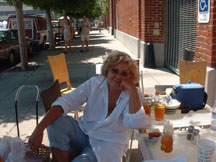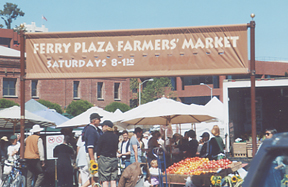Farmers’ markets are sexy. They seduce people. They bring them downtown at night. San Rafael did that. And since 1993, they have been bringing sophisticated San Franciscans to the Wharf—an area of the city where they formerly wouldn’t be caught dead. Farmers’ markets have been used to sell everything from shopping centers to restaurants, just by being there. Even Pacific Bell Park has a market stand with fresh produce on game days.

Jeanette Etheridge, owner of Tosca Cafe in North Beach and a devout Farmers’ Market fan, has been coming since it opened.
The Amazing Success of the Ferry Plaza Market and Its Future
By GraceAnn Walden
Farmers’ markets are sexy. They seduce people. They bring them downtown at night. San Rafael did that. And since 1993, they have been bringing sophisticated San Franciscans to the Wharf—an area of the city where they formerly wouldn’t be caught dead. Farmers’ markets have been used to sell everything from shopping centers to restaurants, just by being there. Even Pacific Bell Park has a market stand with fresh produce on game days.
Farmers’ markets: the simple prospect of urban foodies and suburban home chefs getting in touch with the people that grow and produce their food. What a concept! And beyond the social interaction, the markets put consumers in touch with farm-fresh, just picked-produce, a commodity in scarce supply in our local chain supermarkets.
The public has embraced the idea all over the Bay Area. The Pacific Coast Farmers’ Market Association says that attendance at their 16 markets has jumped 36 percent in the last five years. This year we counted over 70 markets in the Bay Area.
The Ferry Plaza Market
But the crème de la crème of farmers’ markets is the Ferry Plaza Market. Its first trial run was in the fall of 1992, backed by the San Francisco Public Market Collaborative. Founders included the late Joe Weiner, Tom Sargent, and Sibella Kraus, who obtained permission from the Port of San Francisco. It was to be a one-time event, but that Saturday, 100 farmers and 16 restaurants sold their products in a parking lot across from the Ferry Building. So many people came to patronize the market that the Port took notice.
The timing was right. The Embarcadero Freeway had just been torn down, apartments and condos were developed in the neighborhood, and San Francisco, having lost most of the container freight shipping to Oakland, was looking for ways to revitalize the mid-Embarcadero part of the Wharf. It didn’t hurt that the wave of artisanal bakers and cheesemakers and the sustainable and organic farm movement were on the rise since the 1970s.
In May of 1993, a permanent market was established. Over the next few months, patronage built so that when October rolled around, Sibella Kraus said, “Let’s not close.”
“From the beginning,” says Kraus, “the board had a clear vision, and vetoed any idea of including crafts and to also limit the prepared food.”
At one point, there were two entities overseeing and associated with the market, the San Francisco Public Market Collaborative and CUESA, the Center for Urban Education About Sustainable Agriculture. Today, CUESA directs the market.
In 1995, a Tuesday market was established at Justin Herman Plaza. It runs year round from 10:30am-2:30pm. That market remains a mere shadow of the fun-filled social gathering that the Saturday market has become.
One farmer said that he calls the Tuesday market the “popcorn and candy market,” because office workers and execs in suits buy few perishables. “Anything you have to cook doesn’t sell on Tuesdays,” says the same farmer who requested anonymity.
Subsequently, when the Plaza in front of the Ferry Building was slated for renovation and redesign, the market moved to its present location, a parking lot, owned by the city at Green and the Embarcadero. There it has blossomed into something beyond patron and purveyor. On Saturdays, from 8am-1:30pm, it bustles like one would imagine a bazaar in a foreign land might. For many locals, including foodies, nonfoodies, chefs, and the occasional tourist. I is San Francisco’s town square.
The Farmers—The Patrons
Farmers offer everything from flowers to fruit, vegetables to house plants, and small production breads, cheeses, oils and spreads, to name a few. Several restaurants with booths serve breakfast and coffee while musicians serenade the crowd. The “Shop with the Chef” features local restaurant chefs preparing dishes in a mini-cooking class.
Stall fees range from $25 for a small table to $120, with restaurants paying a premium for space, because they are cooking and there are Health Department fees.
Jeanette Etheridge owns the hip Tosca Café, a hangout for the movie crowd in North Beach. “I’ve been coming to the market since the day it opened. It’s my supermarket. The only thing that I buy elsewhere is toilet paper. Today I bought bacon from Enzo’s, some lush peaches, two pieces of halibut, and eggs.”
Another patron for the past two years is Stephanie, who brings her dog Agnes. Since dogs aren’t allowed in the market, but she adds ruefully, doublewide strollers are, she carries Agnes, a Chihuahua, around in a tote bag. She says she buys by the season—peaches, raspberries, avocados, and tomatoes now, chilies in the fall.
The farmers are also enthusiastic. Kathleen and Edmond Weber of Della Fattoria in Petaluma sell their organic breads. “We do this market and Sonoma—these are our stores,” says Kathleen.
Frog Hollow Farms, located in Brentwood, has been at the market since day one. They sell peaches, nectarines, and apricots, plus jams made from the same fruit. Farmer Al Courchesne says he does this market and Tuesday in San Francisco plus the markets in Palo Alto and Berkeley.
On the other hand, Wallace Condon of Small Potatoes in Lodi, who aptly sells potatoes, says that the Saturday market in San Francisco is the only one he does.
The Future
Since 1997, the then organizers and administrators of the market, the San Francisco Public Market Collaborative, spearheaded by Sibella Kraus, pushed for a permanent home in the Ferry Building, a San Francisco landmark at the foot of Market Street originally built in 1898. The market wanted to relocate in the building while the retrofit and redesign was underway. The $90 million project is in high gear and slated to open in spring of 2003.
At that time, the board envisioned not only a public market, a la Europe or Seattle’s Pike Place Market, but an opportunity to educate patrons about sustainable and organic agriculture. “We saw California as having extraordinary agricultural resources and the need to keep it viable for future generations,” says Kraus.
Kraus left CUESA in 2000 and established SAGE, a nonprofit for sustainable agriculture education. Their activities guide for schools, “Kids Cook Farm Fresh Foods,” has just been printed and is available from the California Department of Education.
Today, the dream of a permanent market in the Ferry Building seems closer to being a reality. And even naysayers are more positive about its prospects, now that the developers, Equity Office Properties, has secured 150 parking spaces, are negotiating for 100 more, and might also secure 450 spots in a building owned by the developers a few blocks away.
Project manager Steve Carlin and CUESA and the developers seemed to have worked out a practical plan for the Market in the Ferry Building.
The Saturday market will have more space than it has now and will be two thirds on the Plaza and one third on the Embarcadero under the arcades of the building. It will also span the Bay side of the building to the rear. Other days, farmers, like those at Pike’s Market, will have day tables under the roof but will not be totally enclosed. These will be in the interior and exterior of the arcades.
Some artisanal food purveyors and even some farmers will have permanent stores in the building. Acme Breads of Berkeley has already signed and they will produce all their San Francisco bread there.
Carlin has also signed the Cowgirl Creamery (Artisan Cheese Shop), Peet’s Coffee, the Pasta Shop, and Scharffen Berger Chocolate. He is in negotiations with a fishmonger and a butcher. He admits that he will have to secure a lease with a produce seller to have vegetables and fruits everyday.
Taylor’s Refresher—the original is located on Highway 29 in St Helena—will serve burgers and malts in one of the four restaurant spaces that will anchor the project.
At present, table fees to the farmers in the Ferry Building will remain the same.
Many think the new market will draw tourists, locals, and many ferry commuters, especially after ferry service is expanded.
Most of the farmers we interviewed were enthusiastic about the plans. One small farmer said, “I just hope they don’t mess it up.”
We shall see.

San Francisco’s Farmers’ Market at its current location, across the Embarcadero from the Ferry Building, where it’s headed when the Ferry Building reopens next year.

Proud colors of the San Francisco Farmers’ Market.

